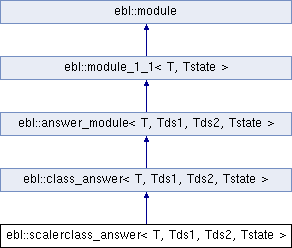ebl::scalerclass_answer< T, Tds1, Tds2, Tstate > Class Template Reference
#include <ebl_answer.h>
Inheritance diagram for ebl::scalerclass_answer< T, Tds1, Tds2, Tstate >:

Public Member Functions | |
| scalerclass_answer (uint nclasses, double target_factor=1.0, bool binary_target=false, t_confidence conf=confidence_max, bool apply_tanh=false, uint jsize=3, uint joffset=0, float mgauss=1.5, bool predict_conf=false, bool predict_bconf=false, idx< T > *biases=NULL, idx< T > *coeffs=NULL, const char *name="scalerclass_answer") | |
| virtual void | fprop (Tstate &in, Tstate &out) |
| virtual void | fprop (labeled_datasource< T, Tds1, Tds2 > &ds, Tstate &out) |
| Produce target matrix into 'out' for training, given a datasource 'ds'. | |
| virtual void | update_log (classifier_meter &log, intg age, idx< T > &energy, idx< T > &answer, idx< T > &label, idx< T > &target, idx< T > &rawout) |
| Update the 'log' according to this type of answer module. | |
| virtual std::string | describe () |
| Returns a string describing this module and its parameters. | |
Protected Attributes | |
| bbstate_idx< T > | jitter |
| A temp buffer to extract jitter info to. | |
| Tstate | out_class |
| Temporary class buffer. | |
| Tstate | tmp1 |
| Temporary buffer. | |
| Tstate | tmp2 |
| Temporary buffer. | |
| uint | jsize |
| Number of jitter elements used. | |
| uint | joffset |
| Offset in jitter elements. | |
| float | scale_mgauss |
| Mean of scale confidence gaussian. | |
| bool | predict_conf |
| Predict confidence. | |
| bool | predict_bconf |
| Predicted confidence is binary or not. | |
| uint | pconf_offset |
| Offset of predicted confidence feature. | |
| std::vector< std::string > | log_fields |
| Names of variables to log. | |
| idx< T > * | biases |
| Normalization biases: scale,h,w,conf. | |
| idx< T > * | coeffs |
| Normalization coeffs: scale,h,w,conf. | |
Detailed Description
template<typename T, typename Tds1 = T, typename Tds2 = T, class Tstate = bbstate_idx<T>>
class ebl::scalerclass_answer< T, Tds1, Tds2, Tstate >
This module gathers information from a labeled_datasource 'ds' and outputs a state of type 'Tstate'. The output state is a 1-of-n target vector given the discret label of the sample concatenated with an additional scale element.
Constructor & Destructor Documentation
template<typename T , typename Tds1 , typename Tds2 , class Tstate >
| ebl::scalerclass_answer< T, Tds1, Tds2, Tstate >::scalerclass_answer | ( | uint | nclasses, |
| double | target_factor = 1.0, |
||
| bool | binary_target = false, |
||
| t_confidence | conf = confidence_max, |
||
| bool | apply_tanh = false, |
||
| uint | jsize = 3, |
||
| uint | joffset = 0, |
||
| float | mgauss = 1.5, |
||
| bool | predict_conf = false, |
||
| bool | predict_bconf = false, |
||
| idx< T > * | biases = NULL, |
||
| idx< T > * | coeffs = NULL, |
||
| const char * | name = "scalerclass_answer< T, Tds1, Tds2, Tstate >" |
||
| ) |
Initialize target vectors given the number of classes.
- Parameters:
-
nclasses The number of classes for classification. target_factor A factor applied to targets. binary_target If true, target is a scalar with -1 or 1. conf The type of confidence. apply_tanh If true, a tanh is applied to inputs (targets only, not scale input). jsize The number of jitter elements to use. joffset The offset to start using jitters. predict_conf Add an extra feature for confidence prediction. predict_bconf If true, predicted confidence is binary (0,1).
Member Function Documentation
template<typename T , typename Tds1 , typename Tds2 , class Tstate >
| void ebl::scalerclass_answer< T, Tds1, Tds2, Tstate >::fprop | ( | Tstate & | in, |
| Tstate & | out | ||
| ) | [virtual] |
Produce a vector of answers given input 'in'. 'out' contains answers in this order: class id and confidence.
Reimplemented from ebl::class_answer< T, Tds1, Tds2, Tstate >.
The documentation for this class was generated from the following files:
- /home/rex/ebltrunk/core/libeblearn/include/ebl_answer.h
- /home/rex/ebltrunk/core/libeblearn/include/ebl_answer.hpp
